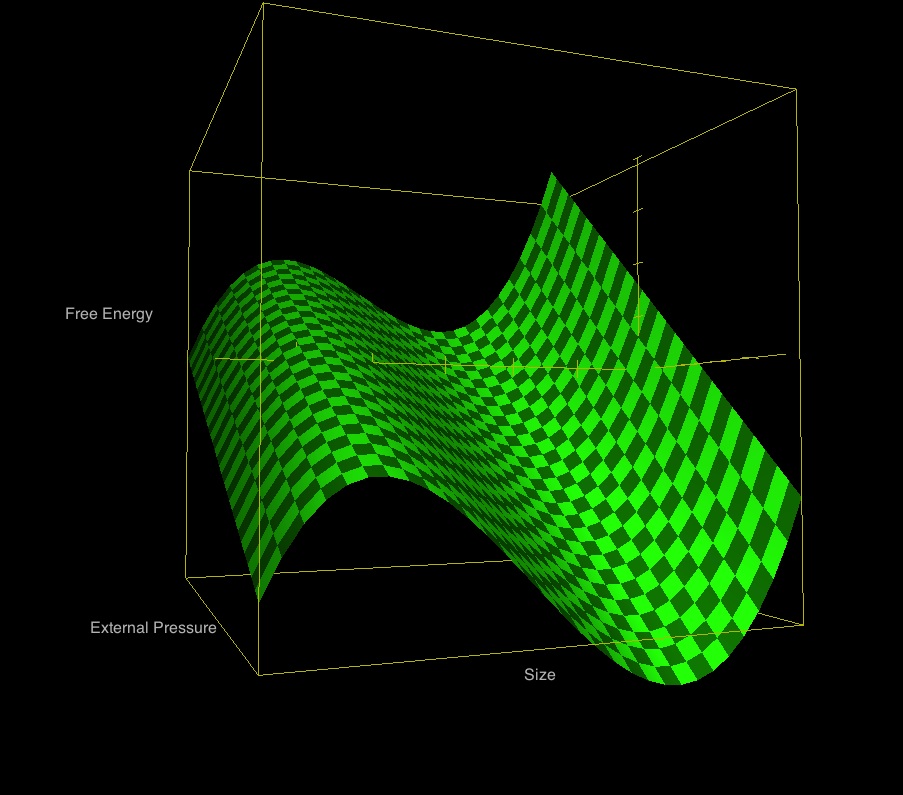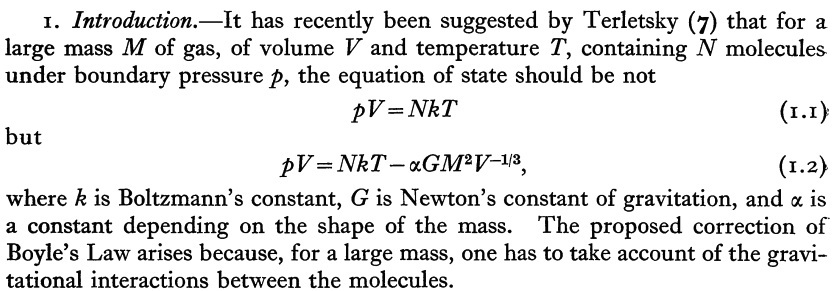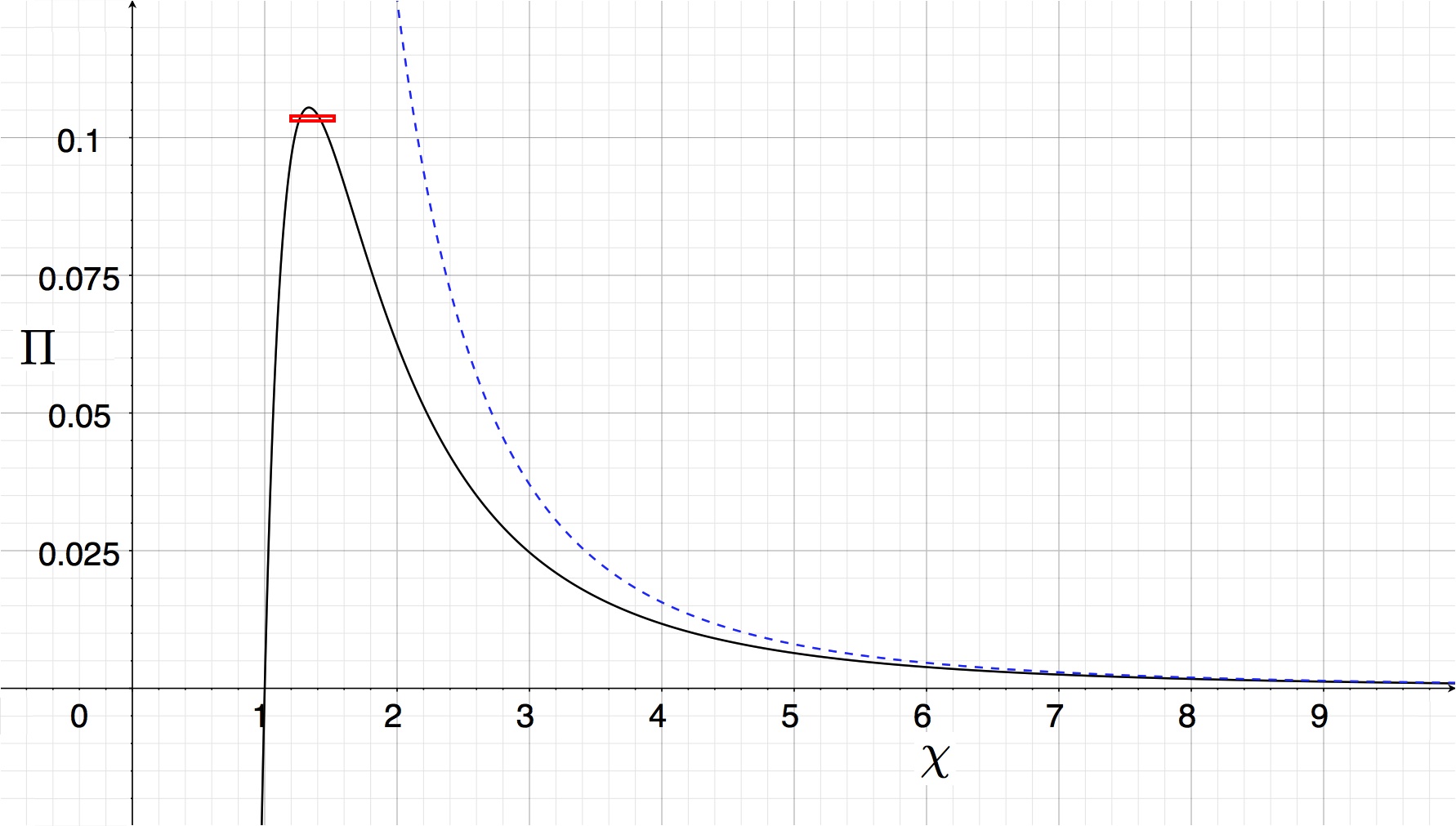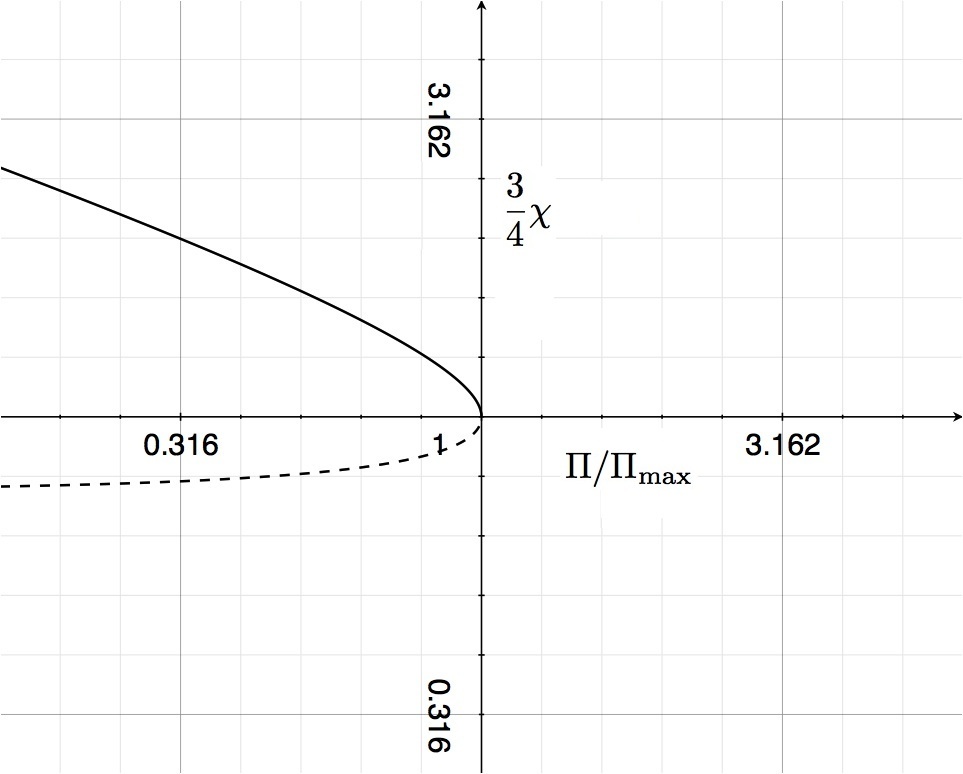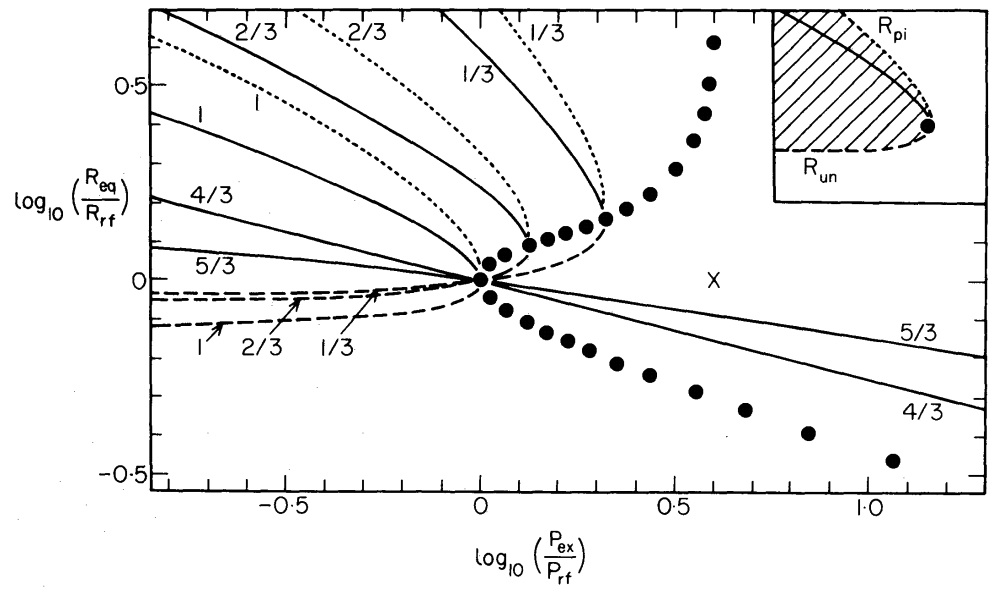Difference between revisions of "User:Tohline/SphericallySymmetricConfigurations/Virial"
m (→Bounded Adiabatic: Corrected typo) |
m (→Quartic Solution: Fix a couple of phrases in caption to Figure 3) |
||
| Line 475: | Line 475: | ||
</math> | </math> | ||
</div> | </div> | ||
Logarithmic units are used along both axes; <math>\Pi</math> is normalized to <math>\Pi_\mathrm{max}</math>; and <math>\chi</math> is normalized to the equilibrium radius <math>(4/3)</math> at <math>\Pi_\mathrm{max}</math>. | Logarithmic units are used along both axes; <math>\Pi</math> is normalized to <math>\Pi_\mathrm{max}</math>; and <math>\chi</math> is normalized to the equilibrium radius <math>(4/3)</math> at <math>\Pi_\mathrm{max}</math>. | ||
''Bottom:'' A reproduction of Figure 1a from [http://adsabs.harvard.edu/abs/1981MNRAS.195..967W Whitworth] (1981, MNRAS, 195, 967). The solid and dashed segments of the curve labeled "1" identify the equilibrium radii, <math>R_\mathrm{eq}</math>, that result from embedding a uniform-density, isothermal <math>(\gamma_\mathrm{g} = 1)</math> gas cloud in an external medium of pressure <math>P_\mathrm{ex}</math>. | ''Bottom:'' A reproduction of Figure 1a from [http://adsabs.harvard.edu/abs/1981MNRAS.195..967W Whitworth] (1981, MNRAS, 195, 967). The solid and dashed segments of the curve labeled "1" identify the equilibrium radii, <math>R_\mathrm{eq}</math>, that result from embedding a uniform-density, isothermal <math>(\gamma_\mathrm{g} = 1)</math> gas cloud in an external medium of pressure <math>P_\mathrm{ex}</math>. | ||
''Comparison:'' The curve shown above that traces out <math>\chi_1(\Pi)</math> and <math>\chi_2(\Pi)</math> should be identical to | ''Comparison:'' The curve shown above that traces out <math>\chi_1(\Pi)</math> and <math>\chi_2(\Pi)</math> should be identical to the "Whitworth" curve labeled "1". | ||
</td> | </td> | ||
<td align="center" bgcolor="white"> | <td align="center" bgcolor="white"> | ||
Revision as of 01:17, 22 October 2012

|
|---|
| | Tiled Menu | Tables of Content | Banner Video | Tohline Home Page | |
Virial Equilibrium
Free Energy Expression (review)
As has been explained elsewhere, associated with any self-gravitating, gaseous configuration we can identify a total "Gibbs-like" free energy, <math>\mathfrak{G}</math>, given by the sum of the relevant contributions to the total energy of the configuration,
<math> \mathfrak{G} = W + U + T_\mathrm{rot} + P_e V + \cdots \, , </math>
where, for the purposes of this discussion, we have explicitly included the gravitational potential energy, <math>W</math>, the total internal energy, <math>U</math>, the rotational kinetic energy, <math>T_\mathrm{rot}</math>, and a term that accounts for surface effects if the configuration of volume <math>V</math> is embedded in an external medium of pressure <math>P_e</math>. For spherically symmetric configurations that have a uniform density and are uniformly rotating, each of the terms contributing to this free-energy expression can be written as a product of a scalar coefficient and a function of the configuration's radius, <math>R</math>, as follows:
<math> \mathfrak{G} = -A\biggl( \frac{R}{R_0} \biggr)^{-1} +~ (1-\delta_{1\gamma_g})B\biggl( \frac{R}{R_0} \biggr)^{-3(\gamma_g-1)} -~ \delta_{1\gamma_g} B_I \ln \biggl( \frac{R}{R_0} \biggr) +~ C \biggl( \frac{R}{R_0} \biggr)^{-2} +~ D\biggl( \frac{R}{R_0} \biggr)^3 \, , </math>
where, <math>R_0</math> is an, as yet unspecified, scale length,
|
<math>A</math> |
<math>\equiv</math> |
<math>\frac{3}{5} \frac{GM^2}{R_0} \, ,</math> |
|
<math>B</math> |
<math>\equiv</math> |
<math> \biggl[ \frac{K}{(\gamma_g-1)} \biggl( \frac{3}{4\pi R_0^3} \biggr)^{\gamma_g - 1} \biggr] M^{\gamma_g} \, , </math> |
|
<math>B_I</math> |
<math>\equiv</math> |
<math> 3c_s^2 M =3 KM \, , </math> |
|
<math>C</math> |
<math>\equiv</math> |
<math> \frac{5J^2}{4MR_0^2} \, , </math> |
|
<math>D</math> |
<math>\equiv</math> |
<math> \frac{4}{3} \pi R_0^3 P_e \, . </math> |
As written here, the coefficient <math>B</math> that appears in the definition of the configuration's total internal energy comes from assuming that the configuration will expand or contract adiabatically, that is, that internally the pressure scales with density as,
<math>P = K \rho^{\gamma_g} \, ,</math>
where <math>K</math> specifies the specific entropy of the gas and <math>~\gamma_\mathrm{g}</math> <math>\ne 1</math> is the ratio of specific heats. (Note that the Kroniker delta function <math>\delta_{1\gamma_g} = 0</math>, since <math>\gamma_g \ne 1</math>.) If compressions/expansions occur isothermally (<math>\gamma_g = 1</math>, hence, <math>\delta_{1\gamma_g} = 1</math>), the relevant <math>P-\rho</math> relationship is,
<math>P = K\rho = c_s^2 \rho \, .</math>
Once the pressure exerted by the external medium (<math>P_e</math>), and the configuration's mass (<math>M</math>), angular momentum (<math>J</math>), and specific entropy (via <math>K</math>) — or, in the isothermal case, sound speed (<math>c_s</math>) — have been specified, the values of all of the coefficients are known and this algebraic expression for <math>\mathfrak{G}</math> describes how the free energy of the configuration will vary with the configuration's size (<math>R</math>) for a given choice of <math>\gamma_g</math>.
Visual Representation
|
Figure 1: Free Energy Surface |
|
|
This segment of the free energy "surface" shows how the free energy varies as the size of the configuration and the applied external pressure are varied, while all other relevant physical attributes are held fixed. The plotted function — derived from the above expression for <math>\mathfrak{G}</math>, with <math>\gamma_\mathrm{g} = 1</math> and <math>C=0</math> (see further discussion, below) — is, specifically, <math> \frac{\mathfrak{G}}{3Mc_s^2} = 3000\biggl[ - \frac{1}{\chi} - \ln\chi + \frac{\Pi}{3}\chi^3 + 0.9558 \biggr] \, . </math> As shown, the size of the configuration <math>(\chi)</math> increases to the right from <math>1.2</math> to <math>1.51</math>; the dimensionless external pressure <math>(\Pi)</math> increases into the screen from <math>0.103</math> to <math>0.104</math>; and the dimensionless free energy, <math>\mathfrak{G}/(3Mc_s^2)</math>, increases upward. |
|
Energy Extrema
As is illustrated in Figure 1, the free energy surface generally will exhibit multiple local minima and local maxima, and may also possess one or more points of inflection. The locations along the energy surface where these special points arise identify equilibrium states, and the associated values of <math>(R/R_0)_\mathrm{eq}</math> give the radii of the equilibrium configurations.
For a given choice of the set of physical parameters <math>M</math>, <math>K</math>, <math>J</math>, <math>P_e</math>, and <math>\gamma_g</math>, extrema occur wherever,
<math> \frac{d\mathfrak{G}}{dR} = 0 \, . </math>
For the free energy function identified above,
<math> \frac{d\mathfrak{G}}{dR} = \frac{1}{R_0} \biggl[ A\chi^{-2} +~ (1-\delta_{1\gamma_g})~3(1 - \gamma_g) B\chi^{2 -3\gamma_g} -~ \delta_{1\gamma_g} B_I \chi^{-1} ~ -2C \chi^{-3} +~ 3D\chi^2 \biggr] \, . </math>
where,
<math>\chi \equiv \frac{R}{R_0} \, .</math>
So <math>\chi_\mathrm{eq} \equiv (R/R_0)_\mathrm{eq}</math> is obtained from the real root(s) of the equation,
<math> A \chi^{-2} +~ (1-\delta_{1\gamma_g})~3(1 - \gamma_g) B\chi^{2 -3\gamma_g} -~ \delta_{1\gamma_g} B_I \chi^{-1} ~ -2C \chi^{-3} +~ 3D\chi^2 = 0 \, , </math>
or, equivalently, from the roots of the equation,
<math> 2C \chi^{-2} + ~ (1-\delta_{1\gamma_g})~3(\gamma_g-1) B\chi^{3 -3\gamma_g} +~ \delta_{1\gamma_g} B_I ~-~A\chi^{-1} -~ 3D\chi^3 = 0 \, . </math>
As a definition of equilibrium states, this last expression is also the well-known scalar virial equation, derivable from the first moment of the equation of motion. A more recognizable expression can be obtained by replacing each of the terms by the energy contents that they represent:
<math> 2(T_\mathrm{rot} + S) + W - 3P_e V = 0 \, . </math>
In this expression, <math>S</math> is the thermal energy content of the configuration; the relationship between <math>S</math> and the configuration's total internal energy, <math>U</math>, is provided in our associated derivation of both the adiabatic and isothermal free energy functions.
Examples
Isolated, Nonrotating Configuration
For a nonrotating configuration <math>(C=J=0)</math> that is not influenced by the effects of a bounding external medium <math>(D=P_e = 0)</math>, the statement of virial equilibrium is,
<math> (1-\delta_{1\gamma_g})~3(\gamma_g-1) B\chi^{3 -3\gamma_g} +~ \delta_{1\gamma_g} B_I ~-~A\chi^{-1} = 0 \, . </math>
Isothermal
For isothermal configurations <math>(\delta_{1\gamma_g} = 1)</math>, one and only one equilibrium state arises where,
<math> B_I = A\chi^{-1} \, , </math>
that is,
<math> R_\mathrm{eq} = R_0 \chi_\mathrm{eq} = \frac{A}{B_I}\cdot R_0 = \frac{GM}{5c_s^2} \, . </math>
Adiabatic
For adiabatic configurations <math>(\delta_{1\gamma_g} = 0)</math>, one equilibrium state exists for each value of <math>\gamma_g</math> and it occurs where,
<math> 3(\gamma_g-1) B\chi^{3 -3\gamma_g} = A\chi^{-1} \, , </math>
that is, where,
<math> R_\mathrm{eq} = R_0 \chi_\mathrm{eq} = \biggl[ \frac{3(\gamma_g-1) B}{A} \cdot R_0^{(3\gamma_g-4)} \biggr]^{1/(3\gamma_g-4)} = \biggl[ 5\biggl( \frac{3}{4\pi} \biggr)^{\gamma_g-1} \cdot \frac{KM^{(\gamma_g-2)}}{G} \biggr]^{1/(3\gamma_g-4)} \, . </math>
Notice that, for <math>\gamma_g=2</math>, the equilibrium radius depends only on the specific entropy of the gas and is independent of the configuration's mass. Conversely, notice that, for <math>\gamma_g = 4/3</math>, the mass of the configuration is independent of the radius. For all other values of <math>\gamma_g</math>, the equilibrium mass-radius relationship for adiabatic configurations is,
<math> M^{(\gamma_g - 2)} \propto R_\mathrm{eq}^{(3\gamma_g -4)} \, . </math>
This means that, for <math>\gamma_g</math> > <math> 2</math> or <math>\gamma_g </math>< <math>4/3</math>, configurations with larger mass (but the same specific entropy) have larger equilibrium radii. However, for <math>\gamma_g</math> in the range, <math>2</math> > <math>\gamma_g </math> > <math>4/3</math>, configurations with larger mass have smaller equilibrium radii.
Note that the result obtained for the isothermal configuration could have been obtained by setting <math>\gamma_g = 1</math> in this adiabatic solution, because <math>K = c_s^2</math> when <math>\gamma_g = 1</math>.
Nonrotating Configuration Embedded in an External Medium
For a nonrotating configuration <math>(C=J=0)</math> that is embedded in, and is influenced by the pressure <math>P_e</math> of, an external medium, the statement of virial equilibrium is,
<math> (1-\delta_{1\gamma_g})~3(\gamma_g-1) B\chi^{3 -3\gamma_g} +~ \delta_{1\gamma_g} B_I ~-~A\chi^{-1} -~ 3D\chi^3 = 0 \, . </math>
Bounded Isothermal
For isothermal configurations <math>(\delta_{1\gamma_g} = 1)</math>, we deduce that equilibrium states exist at radii given by the roots of the equation,
<math> B_I ~-~A\chi^{-1} -~ 3D\chi^3 = 0 \, . </math>
Bonnor's (1956) Equivalent Relation
Inserting the expressions for the coefficients <math>B_I</math>, <math>A</math>, and <math>D</math> gives,
<math> 3Mc_s^2 ~- \frac{3}{5} \frac{GM^2}{R} = 3 P_e \biggl( \frac{4\pi}{3} R^3\biggr) \, , </math>
or, because the volume <math>V = (4\pi R^3/3)</math> for a spherical configuration, we can write,
<math> 3P_e V = 3Mc_s^2 ~- \frac{3}{5} \biggl( \frac{4\pi}{3} \biggr)^{1/3} \frac{GM^2}{V^{1/3}} \, . </math>
It is instructive to compare this expression for a self-gravitating, isothermal equilibrium sphere to the one that was presented in 1956 by Bonnor (1956, MNRAS, 116, 351) as equation (1.2) in a paper titled, "Boyle's Law and Gravitational Instability":
Once we realize that, for an isothermal configuration, twice the thermal energy content, <math>2S</math>, can be written as <math>(3NkT)</math> just as well as via the product, <math>(3Mc_s^2)</math>, we see that our expression is identical to Bonnor's if we set the prefactor on Bonnor's last term, <math>\alpha = (4\pi/3)^{1/3}/5</math>. (Indeed, later on the first page of his paper, Bonnor points out that this is the appropriate value for <math>\alpha</math> when considering a uniform density sphere.)
P-V Diagram
Returning to the dimensionless form of this expression and multiplying through by <math>[-\chi/(3D)]</math>, we obtain,
<math> \chi^4 - \frac{B_I}{3D} \chi + \frac{A}{3D} = 0 \, . </math>
Now, taking a cue from the solution presented above for an isolated isothermal configuration, we choose to set the previously unspecified scale factor, <math>R_0</math>, to,
<math> R_0 = \frac{GM}{5c_s^2} \, , </math>
in which case <math>B_I = A</math>, and the quartic equation governing the radii of equilibrium states becomes, simply,
<math> \chi^4 - \frac{\chi}{\Pi} + \frac{1}{\Pi} = 0 \, , </math>
where,
<math> \Pi \equiv \frac{3D}{B_I} = \frac{4\pi R_0^3 P_e}{3Mc_s^2} = \frac{4\pi P_e G^3 M^2}{3\cdot 5^3 c_s^8} \, . </math>
For a given choice of configuration mass and sound speed, this parameter, <math>\Pi</math>, can be viewed as a dimensionless external pressure. Alternatively, for a given choice of <math>P_e</math> and <math>c_s</math>, <math>\Pi^{1/2}</math> can represent a dimensionless mass; or, for a given choice of <math>M</math> and <math>P_e</math>, <math>\Pi^{-1/8}</math> can represent a dimensionless sound speed. Here we will view it as a dimensionless external pressure.
The above quartic equation can be rearranged immediately to give the external pressure that is required to obtain a particular configuration radius, namely,
<math> \Pi = \frac{(\chi - 1)}{\chi^4} \, . </math>
The resulting behavior is shown by the black curve in Figure 2.
|
Figure 2: Equilibrium P-V Diagram |
|
|
The black curve traces out the function, <math> \Pi = (\chi - 1)/\chi^4 \, , </math> and shows the dimensionless external pressure, <math>\Pi</math>, that is required to construct a nonrotating, self-gravitating, isothermal sphere with an equilibrium radius <math>\chi</math>. The pressure becomes negative at radii <math>\chi < 1</math>, hence the solution in this regime is unphysical. Figure 1 displays the free energy surface that "lies above" the two-dimensional parameter space (<math>1.2 < \chi < 1.51</math>; <math>0.103 < \Pi < 0.104</math>) that is identified here by the thin, red rectangle. |
|
In the absence of self-gravity (i.e., <math>A=0</math>), the product of the external pressure and the volume should be constant. The corresponding relation, <math>\Pi = \chi^{-3}</math>, is shown by the blue dashed curve in the figure. As the figure illustrates, when gravity is included the P-V relationship pulls away from the PV = constant curve at sufficiently small volumes. Indeed, the curve turns over at a finite pressure, <math>\Pi_\mathrm{max}</math>, and for every value of <math>\Pi < \Pi_\mathrm{max}</math> a second, more compact equilibrium configuration appears. The location of <math>\Pi_\mathrm{max}</math> along the curve is identified by setting <math>\partial\Pi/\partial\chi = 0</math>, that is, it occurs where,
<math> \frac{\partial\Pi}{\partial\chi} = -4 \chi^{-5}(\chi - 1) + \chi^{-4} = 0 \, , </math>
<math> \Rightarrow ~~~~~ \chi = \frac{2^2}{3} \approx 1.333333 \, . </math>
Hence,
<math>\Pi_\mathrm{max} = \biggl( \frac{2^2}{3} \biggr)^{-4} \biggl( \frac{2^2}{3}-1 \biggr) = \frac{3^3}{2^8} \approx 0.105469\, .</math>
Quartic Solution
In the above <math>P-V</math> diagram discussion, we rearranged the quartic equation governing equilibrium configurations to give <math>\Pi</math> for any chosen value of <math>\chi</math>. Alternatively, the four roots of the quartic equation — <math>\chi_1</math>, <math>\chi_2</math>, <math>\chi_3</math> and <math>\chi_4</math> in the presentation that follows — will identify the radii at which a spherical configuration will be in equilibrium for any choice of the external pressure, <math>\Pi</math>, assuming the roots are real.
|
Roots of the quartic equation: <math>\chi^4 - \chi \Pi^{-1}+ \Pi^{-1} = 0 </math> |
||||||||||||||||||
where,
and, <math> y_r \equiv \biggl( \frac{1}{2\Pi^2} \biggr)^{1/3} \biggl\{ \biggl[ 1 + \sqrt{1-\frac{2^8}{3^3}\Pi} \biggr]^{1/3} + \biggl[ 1 - \sqrt{1-\frac{2^8}{3^3}\Pi} \biggr]^{1/3} \biggr\} \, , </math> is the real root of the cubic equation, <math> y^3 - \frac{4y}{\Pi} - \frac{1}{\Pi^{2}} = 0 \, . </math> |
Because <math>\Pi</math> must be positive in physically realistic solutions, we conclude that the two roots involving <math>E_q</math> — that is, <math>\chi_3</math> and <math>\chi_4</math> — are imaginary and, hence, unphysical. The other two roots — <math>\chi_1</math> and <math>\chi_2</math> — will be real only if the arguments inside the radicals in the expression for <math>y_r</math> are positive. That is, <math>\chi_1</math> and <math>\chi_2</math> will be real only for values of the dimensionless external pressure,
<math>\Pi \leq \Pi_\mathrm{max} \equiv \frac{3^3}{2^8} \, .</math>
This is the same upper limit on the external pressure that was derived above, via a different approach.
When combined, a plot of <math>\chi_1</math> versus <math>\Pi</math> and <math>\chi_2</math> versus <math>\Pi</math> will reproduce the solid black curve shown in Figure 2, but with the axes flipped. The top-right quadrant of Figure 3 presents such a plot, but in logarithmic units along both axes; also <math>\Pi</math> is normalized to <math>\Pi_\mathrm{max}</math> and <math>\chi</math> is normalized to the equilibrium radius <math>(4/3)</math> at that pressure. This is the manner in which Whitworth (1981, MNRAS, 195, 967) chose to present this result for uniform-density, spherical isothermal <math>(\gamma_\mathrm{g}=1)</math> configurations. Our solid and dashed curve segments — identifying, respectively, the <math>\chi_1(\Pi)</math> and <math>\chi_2(\Pi)</math> solutions to the above quadratic equation — precisely match the solid and dashed curve segments labeled "1" in Whitworth's Figure 1a (replicated here in the bottom-right quadrant of Figure 3).
|
Figure 3: Equilibrium R-P Diagram |
|
|
Top: The solid curve traces the function <math>\chi_1(\Pi)</math> and the dashed curve traces the function <math>\chi_2(\Pi)</math>, where <math>\chi_1</math> and <math>\chi_2</math> are the two real roots of the quartic equation, <math> \chi^4 - \frac{\chi}{\Pi} + \frac{1}{\Pi} = 0 \, . </math> Logarithmic units are used along both axes; <math>\Pi</math> is normalized to <math>\Pi_\mathrm{max}</math>; and <math>\chi</math> is normalized to the equilibrium radius <math>(4/3)</math> at <math>\Pi_\mathrm{max}</math>. Bottom: A reproduction of Figure 1a from Whitworth (1981, MNRAS, 195, 967). The solid and dashed segments of the curve labeled "1" identify the equilibrium radii, <math>R_\mathrm{eq}</math>, that result from embedding a uniform-density, isothermal <math>(\gamma_\mathrm{g} = 1)</math> gas cloud in an external medium of pressure <math>P_\mathrm{ex}</math>. Comparison: The curve shown above that traces out <math>\chi_1(\Pi)</math> and <math>\chi_2(\Pi)</math> should be identical to the "Whitworth" curve labeled "1". |
|
Bounded Adiabatic
For adiabatic configurations <math>(\delta_{1\gamma_g} = 0)</math>, equilibrium states exist at radii given by the roots of the following expression:
<math> 3(\gamma_g-1) B\chi^{3 -3\gamma_g} ~-~A\chi^{-1} -~ 3D\chi^3 = 0 \, . </math>
This is precisely the same condition that derives from setting equation (3) to zero in Whitworth's (1981, MNRAS, 195, 967) discussion of the "global gravitational stability for one-dimensional polytropes." The overlap with Whitworth's narative is perhaps clearer after introducing the algebraic expressions for the coefficients <math>A</math>, <math>B</math>, and <math>D</math>, dividing the equation through by <math>(3\chi^3 V_0) = (4\pi R^3)</math>, and rewriting <math>R</math> as <math>R_\mathrm{eq}</math> to obtain,
<math> P_e = K \biggl( \frac{3M}{4\pi R_\mathrm{eq}^3} \biggr)^{\gamma_g} - \biggl( \frac{3GM^2}{20\pi R_\mathrm{eq}^4} \biggr) \, . </math>
This exactly matches equation (5) of Whitworth, which reads:
Ideally we would like to invert this equation to obtain an analytic expression for the configuration's equilibrium radius in terms of the physical parameters, <math>M</math>, <math>K</math>, and <math>P_e</math>. However, this cannot be accomplished for an arbitrary value of the adiabatic exponent, <math>\gamma_g</math>.
Other?
Show that derived result is, essentially, the Bonnor-Ebert sphere. Should we also draw analogy with collapse of isothermal core of red giant, or leave this to the later stability discussion?

|
|---|
|
© 2014 - 2021 by Joel E. Tohline |
